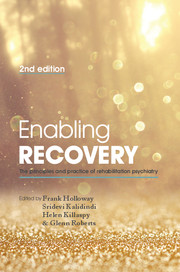Book contents
- Frontmatter
- Contents
- List of contributors
- List of figures, tables and boxes
- Preface
- Part 1 Setting the scene
- Part 2 Treatment approaches
- Part 3 Key elements of a rehabilitation service
- 16 Key elements of a rehabilitation service: overview
- 17 Rehabilitation in hospital settings
- 18 Community-based rehabilitation and recovery
- 19 Housing: a place to live
- 20 Work and employment
- 21 Peer support in mental health services
- 22 Leadership, management and service development in rehabilitation practice
- Part 4 Special topics in psychiatric rehabilitation
- Part 5 Future directions
- Index
16 - Key elements of a rehabilitation service: overview
from Part 3 - Key elements of a rehabilitation service
Published online by Cambridge University Press: 02 January 2018
- Frontmatter
- Contents
- List of contributors
- List of figures, tables and boxes
- Preface
- Part 1 Setting the scene
- Part 2 Treatment approaches
- Part 3 Key elements of a rehabilitation service
- 16 Key elements of a rehabilitation service: overview
- 17 Rehabilitation in hospital settings
- 18 Community-based rehabilitation and recovery
- 19 Housing: a place to live
- 20 Work and employment
- 21 Peer support in mental health services
- 22 Leadership, management and service development in rehabilitation practice
- Part 4 Special topics in psychiatric rehabilitation
- Part 5 Future directions
- Index
Summary
Introduction
Part 3 of the book describes the main components of the ‘whole system’ mental health rehabilitation care pathway referred to in Chapter 2, ‘What is psychiatric rehabilitation?’ Patients with complex mental health needs are usually referred to rehabilitation services from acute in-patient services and secure services. They may move through a series of treatment and support environments over a number of years, with each stage providing the opportunity for them to gain the confidence and skills to manage their lives with greater independence and autonomy, building on their progress and recovery incrementally. The pathway is shown in summary in Fig. 16.1. It includes a range of in-patient mental health rehabilitation units, some of which may actually be based in a community setting rather than a hospital (see Chapter 17, ‘Rehabilitation in hospital settings’), a range of supported accommodation services (see Chapter 19, ‘Housing: a place to live’), vocational rehabilitation services (see Chapter 20, ‘Work and employment’) and peer support services (see Chapter 21, ‘Peer support in mental health services’). Once out of hospital, individuals are also supported by primary care and statutory community mental health services, including community rehabilitation teams and assertive outreach teams (see Chapter 18, ‘Community-based rehabilitation and recovery’).
Providing a flexible pathway
The exact configuration of in-patient rehabilitation services varies in different localities according to morbidity and need, with inner-city areas tending to require more high-dependency in-patient rehabilitation units, from where service users generally move on to a community-based rehabilitation unit in preparation for more independent, but supported, community living. Most (67%) people who require in-patient rehabilitation, whether delivered in a hospital or in a community-based unit, are able to move on successfully to some form of supported accommodation within 3 years (Killaspy & Zis, 2013).
Community rehabilitation services work closely with supportedaccommodation services to provide comprehensive support to service users as they continue their recovery in the community. When service users are able to manage with less support they move on to less-supported accommodation.
- Type
- Chapter
- Information
- Enabling Recovery , pp. 257 - 261Publisher: Royal College of PsychiatristsPrint publication year: 2015



